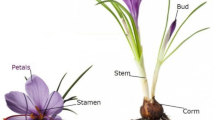Abstract
Saffron is the most expensive spice derived from the flower of Crocus sativus. The purpose of this study is to determine the vitamin B2 level in saffron using a trustable, easy, and sensitive analytical method and therefore to provide the missing information on the nutritional value of this spice. In our current study, by separating with the fast separation technique capillary electrophoresis (CE) and using a laser-induced fluorescence (LIF) detector which is both sensitive and discriminating from other UV active ingredients, the precise determination of vitamin B2 in saffron was achieved. Saffron samples were extracted by boiling water and directly injected to the separation buffer, borate at pH 9.5. The repeatability of the peak areas (%RSD) of riboflavin for intraday and interday was in the satisfactory range of equal to or less than 2.32 and 4.70 %, respectively. The limit of detection (LOD) and limit of quantification (LOQ) values for the method were 4.15 and 13 nM, respectively. Determination of riboflavin was performed by the standard addition method. Riboflavin contents of five saffron samples from two of the biggest producers in the global market (Iran and Spain) were in the range of 5.02–13.86 μg/g.

Similar content being viewed by others
References
Başkan S, Tezcan F, Köse S, Öztekin N, Erim FB (2010) Non-ionic micellar electrokinetic chromatography with laser-induced fluorescence: a new method tested with biogenic amines in brined and dry-salted fish. Electrophoresis 35:2174–2179
Bhat JV, Broker R (1953) Riboflavin and thiamin contents of saffron, Crocus sativun Linn. Nature 172:544
Bolhassani A, Khavari A, Bathaie SZ (2014) Saffron and natural carotenoids: biochemical activities and anti-tumor effects. BBA-Rev Cancer 1845:20–30
Cataldi TRI, Nardiello D, Benedetto GED, Bufo SA (2002) Optimizing separation conditions for riboflavin, flavin mononucleotide and flavin adenine dinucleotide in capillary zone electrophoresis with laser-induced fluorescence detection. J Chromatogr A 968:229–239
Cataldi TRI, Nardiello D, Carrara V, Benedetto GED (2003) Assessment of riboflavin and flavin content in common food samples by capillary electrophoresis with laser-induced fluorescence detection. Food Chem 82:309–314
Chen J, Sun J, Liu S (2013) Determination of riboflavin in cereal grains by capillary electrophoresis with laser-induced fluorescence detection with on-line concentration. Anal Lett 46:887–899
Esteve MJ, Farré R, Frígola A, García-Cantabella JM (2001) Simultaneous determination of thiamin and riboflavin in mushrooms by liquid chromatography. J Agric Food Chem 49:1450–1454
Garcia-Canas V, Simo C, Castro-Puyana M, Cifuentes A (2014) Recent advances in the application of capillary electromigration methods for food analysis and foodomics. Electrophoresis 35:147–169
Gliszczyńska-Świgło A, Koziołowa A (2000) Chromatographic determination of riboflavin and its derivatives in food. J Chromatogr A 881:285–297
Hu L, Yang X, Wang C, Yuan H, **ao D (2007) Determination of riboflavin in urine and beverages by capillary electrophoresis with in-column optical fiber laser-induced fluorescence detection. J Chromatogr B 856:245–251
Hustad S, Ueland PM, Schneede J (1999) Quantification of riboflavin, flavin mononucleotide, and flavin adenine dinucleotide in human plasma by capillary electrophoresis and laser-induced fluorescence detection. Clin Chem 45:862–868
Melnyk JP, Wang S, Marcone MF (2010) Chemical and biological properties of the world’s most expensive spice: saffron. Food Res Int 43:1981–1989
Pérez-Ruiz T, Martínez-Lozano C, Sanz A, Bravo E (2001) Determination of riboflavin, flavin mononucleotide and flavin adenine dinucleotide in biological tissues by capillary zone electrophoresis and laser-induced fluorescence detection. Electrophoresis 22:1170–1174
Rahaiee S, Moini S, Hashemi M, Shojaosadati SA (2015) Evaluation of antioxidant activities of bioactive compounds and various extracts obtained from saffron (Crocus sativus L.): a review. J Food Sci Technol 52:1881–1888
Rios JL, Recio MC, Giner RM, Mhnez S (1996) An update review of saffron and its active constituents. Phytother Res 10:189–193
Sampathu SR, Shivashankar S, Lewis YS, Wood AB (1984) Saffron (Crocus sativus linn)—cultivation, processing, chemistry and standardization. CRC Crit Rev Food Sci Nutr 20:23–157
Sastry LVL, Srinivasan M, Subrahmanyan V (1955) Saffron (Crocus sativus L). J Sci Ind Res 14:178–184
Tang X, Cronin DA, Brunton NP (2006) A simplified approach to the determination of thiamine and riboflavin in meats using reverse phase HPLC. J Food Compos Anal 19:831–837
Tezcan F, Uzaşcı S, Uyar G, Öztekin N, Erim FB (2013) Determination of amino acids in pomegranate juices and fingerprint for adulteration with apple juices. Food Chem 141:1187–1191
Uzaşcı S, Erim FB (2014) Enhancement of native fluorescence intensity of berberine by (2-hydroxypropy1)-beta-cyclodextrin in capillary electrophoresis coupled by laser-induced fluorescence detection: application to quality control of medicinal plants. J Chromatogr A 1338:184–187
Uzaşcı S, Başkan S, Erim FB (2012) Biogenic amines in wines and pomegranate molasses-a non-ionic micellar electrokinetic chromatography assay with laser-induced fluorescence detection. Food Anal Methods 5:104–108
Zhang Z, Wang CZ, Wen XD, Shoyama Y, Yuan CS (2013) Role of saffron and its constituents on cancer chemoprevention. Pharm Biol 51:920–924
Acknowledgments
We thank the Research Foundation of Istanbul Technical University for the financial support.
Author information
Authors and Affiliations
Corresponding author
Ethics declarations
Funding
This study was funded by the Research Foundation of Istanbul Technical University.
Conflict of Interest
F. Bedia Erim declares that she has no conflict of interest. Parya Hashemi declares that she has no conflict of interest.
Ethical Approval
This article does not contain any studies with human participants or animals performed by any of the authors.
Informed Consent
Not applicable.
Rights and permissions
About this article
Cite this article
Hashemi, P., Erim, F.B. Analysis of Vitamin B2 in Saffron Stigmas (Crocus sativus L) by Capillary Electrophoresis Coupled with Laser-Induced Fluorescence Detector. Food Anal. Methods 9, 2395–2399 (2016). https://doi.org/10.1007/s12161-016-0430-9
Received:
Accepted:
Published:
Issue Date:
DOI: https://doi.org/10.1007/s12161-016-0430-9




